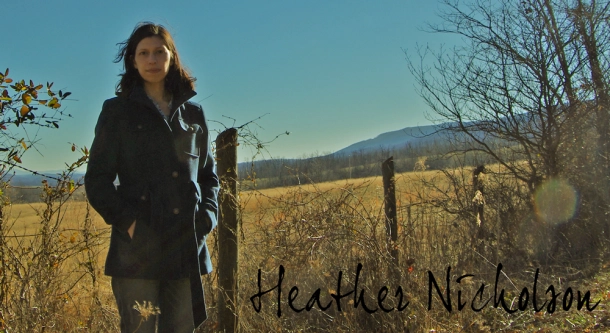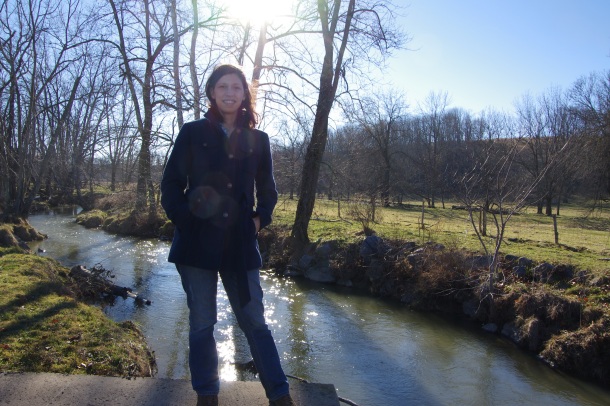About Scratch Cradle
Growing up in central New Jersey, I lived in a very urban suburbia. My parents love camping, hiking, and backpacking and would take my younger brother and me camping at least once a summer. As we got older, my parents took over our Boy Scout and Girl Scout groups, and so we were able to have truly active, exciting scouting experiences. I have also always been very interested in history – not disconnected dates, names, and facts, but the flesh-and-blood history of how real people actually lived in this same space at another time. I loved Laura Ingalls Wilder and Revolutionary War summer camps. What appealed to me was the richness and depth that traditional skills involve and also the connection to nature and the ever-changing, becoming, cyclical patterns of existence they align with. I love the intersection of theory and practice; I love the process that results in the product.
I left New Jersey for Staunton, Virginia. I was a philosophy nut and came down for college. It was quite a culture shock, but I grew to love the area. In the mountains, you can see wave after wave of land until you can’t distinguish where the mountains end and the clouds begin. The land felt so rich, warm, and mysterious that I fell in love and decided to stay. My college roommate was vegan and got me into organic food and natural personal care products. I experimented with gardening, composting, baking, and cooking, and the more I learned, the more curious I became. Years later, I lived on a little over three acres in a small mountain town of 2,000 people.
I enjoy researching and growing heirloom vegetables, baking bread, cooking, and writing. I began keeping chickens in early 2011, and that has been a fun, rewarding hobby. I am always looking for ways to live a bit healthier, fresher, and be more self-reliant, but I don’t push myself or apply guilt; I do what I feel inspired and energized to do. I teach English for a living, love to write, and just finished up a Masters in Educational Psychology. I enjoy writing poetry, stories, and journals, and am playing with a novel or two. I enjoy writing about my life, the way I like to do things, and why I choose to do them that way.
Thank you for joining me on my journey!
Scratch Cradle is a participant in the Amazon Services LLC Associates Program, an affiliate advertising program designed to provide a means for sites to earn advertising fees by advertising and linking to amazon.com.




I too am hatching chicks and have enjoyed your website tremendously. I now know why our little guy/girl, Weeble was stuck in the shell. I have really learned a lot.
I did my Masters in Educational Psychology in new York in 1995-96 and am working in the Mental health field. My husband & I live on 2 1/2 acres on the Sunshine Coast in British Columbia. We have just hatched 5 eggs (the hard way) and have 5 little darlings, 3 broody hens that go on strike around day 16-20 depending on their whim. Oh, and I love to bake….not much for cooking though, my husband is a whiz in the kitchen.
Thank you so much for visiting! I’m glad you enjoyed the site. The area you live in looks beautiful! I’m hoping for some of my hens to grow up and be good broodies, but a day 20 strike would be upsetting! Good luck with those ladies. How is Weeble doing? I love the name.
Hello! I followed your link from Backyard Chickens because I saw you are in Western Virginia. I live in Augusta County, about 12 miles south of Staunton. Although you don’t actually say where your little mountain town is, if you are still in the Shenandoah Valley, you should join us in the Shenandoah Valley Poultry and Gardening Club, organized by Pat Foreman, author of Chicken Tractor, City Chicks, Day Range Poultry, etc. Here’s the link: http://www.meetup.com/Shenandoah-Valley-Poultry-and-Garden-Club/
Thank you so much for informing me about this group! I just read your homepage, and it sounds right up my alley. I’m going to read more this morning and will try to attend a meeting!
I really enjoyed meeting you and talking with you at the poultry exhibit on Saturday at Expo. I found a lot of interesting and useful information on your website. I have been organic gardening for a number of years, and recently once again started raising chickens. You are so right about the cost of raising chickens especially organically. But will be worth it. I have been purchasing eggs from the Farmer’s Market in Nelson County and paying $3.50/egg. Certified organic egg sell here for $4.50/doz. Can’t wait to see my first egg which I expect around August 1.
It was great talking to you as well! My first eggs will be about a month after yours, and I can’t wait! I really hope you enjoy raising your girls. I love just sitting outside and watching them. Thanks for visiting, and I hope to see you again at another show one day!
I love reading your informative and beautiful posts and your interest in heritage chickens so I nominated your site for the “Versatile Blogger Award.” Congratulations! If you go to http://versatilebloggeraward.wordpress.com/ or my site (http://bibliopharm.wordpress.com/), you will find the information on the award, how to pass it along and then you can download the badge on your site if you want.
Enjoy your posts, as I too have hatch some Basque hens from eggs about 11 weeks ago(7 turning out to be roosters) and 2 hens… Can you tell me why some have white legs and some have yellow legs? Thanks,Tommy
That’s quite a few boys! At least you will have your pick of roosters and will be able to pick the very best to father your future flock. Basically, white skin is dominant over yellow skin. If either parent bird gives their offspring a white-skin gene (W), they will have white shanks. Still, they may carry the yellow skin gene and be able to pass it on to their offspring. The yellow skin gene is recessive. If both parents give the offspring a gene for yellow skin, you will see yellow shanks (ww). Many Basque Hens still have the white skin trait, but you can get yellow shanks by breeding yellow to yellow. If you have white-skinned birds carrying the yellow trait (Ww), you can breed them together and about 25% of the offspring will have yellow legs. I do plan to do this at some point, but I want to focus on more foundational aspects such as type and vigor before selecting for color. Because it is recessive, it can be teased out again later as long as some of the birds still carry the yellow skin gene, even hidden. I’ll cover this later this summer in my genetic mini-series which will start this Sunday.
and be able to pass it on to their offspring. The yellow skin gene is recessive. If both parents give the offspring a gene for yellow skin, you will see yellow shanks (ww). Many Basque Hens still have the white skin trait, but you can get yellow shanks by breeding yellow to yellow. If you have white-skinned birds carrying the yellow trait (Ww), you can breed them together and about 25% of the offspring will have yellow legs. I do plan to do this at some point, but I want to focus on more foundational aspects such as type and vigor before selecting for color. Because it is recessive, it can be teased out again later as long as some of the birds still carry the yellow skin gene, even hidden. I’ll cover this later this summer in my genetic mini-series which will start this Sunday.
so is the white legs or the yellow legs standard in Basque hens and I heard a lot of comments on the tail feathers should be more black bars with white? Thanks!!
The yellow legs are standard, and you are right about the tail. A group of people have been working on a North American standard based upon the Spanish standard over on the EO Forum. Here is a link to the standard: http://forums.euskaloiloas.com/viewtopic.php?id=472. Right now, it says that the male’s tail should be “alternating bars of black and white. Sickles the same as the main tail with lustrous greenish black. Coverts black and white barring, the white barring gradually turning to buff approaching the saddle,” and for the female, “Main tail black, shaft buff, two top feathers may be edged with buff.” The forum is a great resource! You can join in the discussion if you like!
Hi Heather, i was very interested in your information regarding blue egg genetics, i am trying to create a flock of cream crested legbars that are pure for the blue egg gene is this possible? and if so would i be right in thinking that the cockerels produced from such a flock would all have the double blue gene.
i can test the cockerels by mating them with non blue egg layers can i do the reverse with the pullets?
i would be very grateful for your advice.
regards Nick
I am sure that is possible, and I would imagine that most flocks of blue egg breeds such as Ameraucana and Cream Legbars are primarily homogeneous. You can definitely test cross the pullets in the same way as the cockerels: Cross the blue egg laying pullet with a white-egg breed cockerel. If any of the female offspring lay white eggs, then she was heterogeneous and carrying the white gene. If all offspring lay blue eggs, then she was homogeneous. Good luck, Nick!
Ran across your site and read for a while and enjoyed what I read. I’m in Alabama , live in the country where I enjoy gardening and wildlife too. I’m interested in raising chickens and maybe even some quail and I’ll be coming back here to enjoy some more reading and learning.
Thanks, Gil
Thank you very much, Gil! I’ve thought about quail myself. Maybe one day! I love living close to nature, and I’m moving this year to 33 acres in northwest Arkansas. I can’t wait. It is so wild there. Thank you for stopping by!
Just read your article on fermented feed, i am a true believer in the “Holy Trinity”
Garlic DE and ACV..but I’m sure my ‘Girls’ would enjoy this treat even more!!!
Thanks for all the Wonderful information.
I am with you on all of that! Thanks, Darcy. I am sure your ‘girls’ will love it!
Scratch Cradle is this weeks TBN’s Featured Blog in a Series. Congratulations! http://tbnranch.com/2013/03/09/scratch-cradle-tbns-featured-blog-in-a-series/
I’m looking for my father…he would like some Brown Rosecomb Leghorn Bantums. Would you have any of this kind?
Great articles on chicken genetics. I very much appreciate the fact that you researched the science and explained it clearly.
wow your mini-series and other info it’s very useful and been achieved very simple the explication! tnx